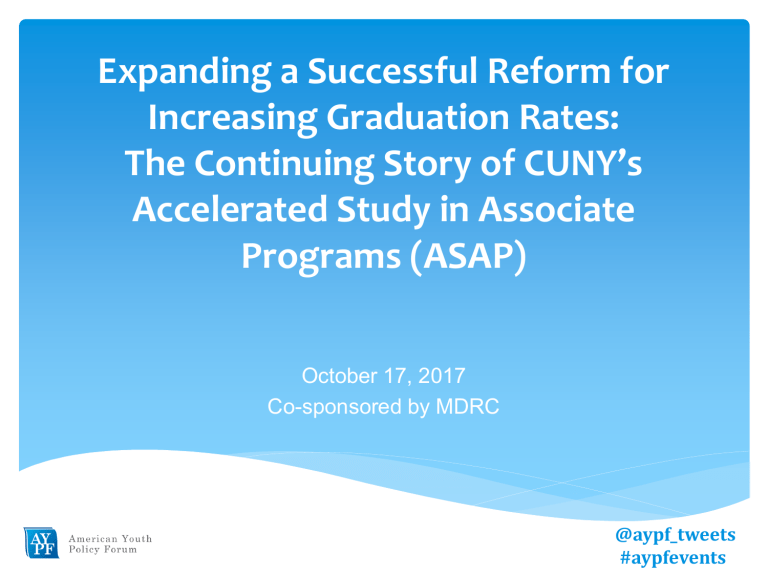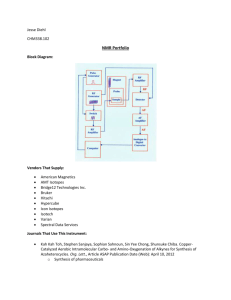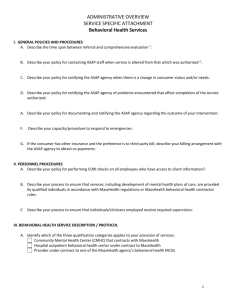to the presentation slides
advertisement

Expanding a Successful Reform for Increasing Graduation Rates: The Continuing Story of CUNY’s Accelerated Study in Associate Programs (ASAP) October 17, 2017 Co-sponsored by MDRC @aypf_tweets #aypfevents Presenters Donna Linderman, University Associate Dean for Student Success Initiatives, CUNY Sue Scrivener, Senior Associate, MDRC Loukman Lamany, Bronx ASAP grad and Baruch College graduate #aypfevents IMPROVING STUDENT RETENTION AND GRADUATION CUNY Accelerated Study in Associate Programs (ASAP) Comprehensive Supports and Assessments American Youth Policy Forum Washington DC October 17, 2014 #aypfevents BARRIERS TO SUCCESS Students are poorly prepared Education is often competing for their time Colleges are large with many departments, majors and procedures “Minimize students’ uncertainty to increase engagement.” Former CUNY Chancellor Mathew Goldstein #aypfevents CUNY COMMUNITY COLLEGE STUDENTS Enter with developmental needs 79% Re-enroll after a year Graduate in 3 years 14% Source: CUNY Office of Institutional Research 2014 66% ASAP THEORY OF ACTION Remove financial barriers to full-time study Provide structured degree pathways and comprehensive, well-coordinated support services Establish clear expectations for all students Build community through early engagement and cohort model Better engaged students who graduate in a timely manner Goal: At least 50% of students will complete an associate degree within three years #aypfevents ASAP HISTORY 2007: CUNY funded by Mayor’s Center for Economic Opportunity (CEO) for threeyear pilot ASAP launched with 1,132 fully skills proficient students* across six CUNY community colleges in the fall * 28% of fall 2007 ASAP students had some developmental needs when recruited that were addressed over summer. #aypfevents ASAP HISTORY 2009: Two-year graduation (cohort 1): 30% ASAP vs. 11% comparison group ASAP begins to admit students with some developmental needs* 2010: Three-year graduation (cohort 1): 55% ASAP vs. 24% comparison group ASAP funding “baselined” to CUNY by CEO 2011/2012: Three-year graduation (cohort 2): 56% ASAP vs. 23% comparison group CUNY Chancellor announces ASAP expansion plans *One to two developmental course needs based on CUNY Assessment Test scores at time of application. ASAP TODAY Major expansion over past three years: Fall 2012: 2,259 students Fall 2013: 3,200 students Fall 2014: 4,300 students In 2014 ASAP serves about: 0 20% #aypfevents of first-time full-time CUNY community college students ASAP SELECTION CRITERIA Must be a New York City resident Agree to study full-time in an ASAPapproved major Continuing/transfer students: no more than 15 credits and good academic standing Have no more than two developmental course needs Receive some need-based financial aid (Pell and/or TAP) #aypfevents Summary Profile of Combined ASAP and Comparison Group Cohorts Cohorts 1 to 7 (2007-2013) Total Enrollment Gender Male Female Ethnicity American Indian/Native Alaskan Asian/Pacific Islander Black Hispanic White Mean Age Admission Type First-time Freshmen Transfer Students Continuing Students Developmental Students At Time of Application to ASAP At Time of Entry into ASAP College Admissions Average GED Recipients Pell Receipt N Combined ASAP Students 6,389 Combined Comparison Group Students 19,274 % % 41.9 58.1 44.4 55.6 % % % % % mean 0.4 11.5 32.0 42.6 13.6 21.4 0.4 14.1 29.1 39.9 16.5 21.2 % % % % % % mean % % 66.6 7.1 26.3 51.6 17.8 30.6 80.1 69.7 76.0 11.6 74.3 77.0 69.2 74.3 11.3 85.2 Source: CUNY's Institutional Research Database (IRDB). ASAP CORE ELEMENTS Financial Resources Tuition waivers Free use of textbooks Monthly Metrocards Structured Pathways Consolidated full-time course schedules First-year blocked courses Immediate/continuous developmental course taking Winter and summer courses Comprehensive Supports High-touch advisement Embedded career development Mandated tutoring for some students ASAP Summer Institute ASAP College Success Seminar #aypfevents ASAP PROGRAM ORGANIZATION ASAP Bronx ASAP BMCC ASAP Queensborough ASAP Medgar Evers CUNY Academic Affairs ASAP LaGuardia #aypfevents ASAP Hostos ASAP Kingsborough ASAP EVALUATION INTERNAL EVALUATION Ongoing quasi-experimental analysis Web-based data management system Annual student surveys and focus groups Data reviewed regularly to assess impact, measure movement towards goals, and constantly improve program practice EXTERNAL EVALUATION Five-year random assignment study by MDRC Cost-benefit study by the Center for Benefit-Cost Studies in Education (CBCSE), Teachers College, Columbia University led Dr. Henry Levin #aypfevents Movement Through Developmental Education for Combined ASAP and Comparison Group Cohorts ASAP 90,0% Comparion Group 82,5% 79,7% 71,3% 80,0% 73,0% 70,0% 60,0% 41,1% 50,0% 40,0% 30,0% 16,3% 20,0% 10,0% 0,0% Dev Ed Need at Application Source: CUNY Institutional Research Database Dev Ed Need at Entry Dev Ed Remaining 3rd Sem Average Graduation Rates of ASAP and Comparison Group Students: Fall 2007-Fall 2012 Cohorts 60% ASAP 51,9% 50,6% Comparison Group 58,7% 48,0% 50% 40,8% 37,9% 40% 35,7% 30% 27,4% 26,1% 22,2% 20,0% 19,8% 19,0% 20% 14,8% 13,2% 12,6% 9,0% 10% 6,5% 0% All Dev Edu Need Fully Proficient 2-Year Graduates (ASAP N=4,547; Comp N=19,087) All Dev Edu Need Fully Proficient 2.5-Year Graduates (ASAP N=2,985; Comp N=15,042) Source: CUNY Office of Institutional Research and Assessment, CUNY ASAP participating colleges, and National Student Clearinghouse. October 9, 2014 All Dev Edu Need Fully Proficient 3-Year Graduates (ASAP N=2,985; Comp N=15,042) 3-Year Graduation Rates for ASAP Cohort 5 and Comparison Group Students Preliminary College Total 2-Yr Graduates Total Total 3-Yr Graduates N N % N % Fall 2011 ASAP Students BMCC BMCC Evening Bronx Hostos Kingsborough LaGuardia Queensborough TOTAL 51 13 72 42 140 82 75 475 14 3 28 19 50 21 20 155 27.5 23.1 38.9 45.2 35.7 25.6 26.7 32.6 28 7 49 24 80 44 39 271 54.9 53.8 68.1 57.1 57.1 53.7 52.0 57.1 College Total Fall 2011 Comparison Group BMCC BMCC Evening Bronx Hostos Kingsborough LaGuardia Queensborough TOTAL Total 2-Yr Graduates Total 3-Yr Graduates N N % N % 1,224 53 267 142 1,058 791 994 4,529 101 10 24 16 105 67 79 402 8.3 18.9 9.0 11.3 9.9 8.5 7.9 8.9 333 17 56 41 265 181 234 1,127 27.2 32.1 21.0 28.9 25.0 22.9 23.5 24.9 Source: CUNY's Administrative Data Warehouse (ADW); data will be verified once it is available in CUNY's Institutional Research Database (IRDB). ASAP COST-BENEFIT STUDY BY LEVIN AND GARCIA Cost Effectiveness Report (September 2012): ASAP saves $6,500 per graduate vs. comparison group Analysis suggests ASAP is a wise up-front investment Cost Benefits Report (May 2013): Increased lifetime earnings and tax revenues and savings to public assistance, criminal justice, and public health Total net benefit for 1,000 enrolled ASAP students=$46.5 million higher than for 1,000 comparison group students Source: Center for Benefit-Cost Studies in Education (CBCSE) #aypfevents ASAP EXPANSION, COSTS AND REPLICATION Expanded to 4,300 students in fall 2014 Will expand to 13,000 students by 2016/17 Costs* are Dropping: Pre-expansion annual cost per student=$6,000 FY15 annual cost per student =$3,900 ASAP replication demonstration project in Ohio In partnership with MDRC, Ohio Board of Regents, Great Lakes Higher Education Corporation, and three community colleges *ASAP costa are above usual CUNY community college FTE allocations. #aypfevents Evaluation of CUNY ASAP Sue Scrivener Senior Associate #aypfevents 20 Why Look at ASAP? CUNY’s ASAP is comprehensive and long-lasting • Brings together many promising reforms • Provides services for three years One of the most ambitious efforts in the country to boost graduation rates for community college students #aypfevents The Evaluation MDRC studied the implementation and cost of ASAP, and its impacts on students’ academic outcomes over three years Study took place at three of CUNY’s community colleges: Borough of Manhattan, Kingsborough, and LaGuardia #aypfevents Random Assignment Research Design Target Consent & Data Random Assignment • Targeted students invited to participate in study • Participants give consent • Baseline data collected • Program group – Students can enroll in ASAP • Control group – Students can receive standard college services #aypfevents Evaluation Target Group Family income at or below 200% of federal poverty level or Pell-eligible Needed one or two developmental courses ASAP also serves college-ready students but they were not included in the MDRC study Incoming freshman or continuing student with 12 or fewer credits and 2.0+ GPA Willing to attend school full time #aypfevents Characteristics of Students at Start of the Evaluation 900 students randomly assigned in 2010 62% women Average age 21.5 Racially diverse 6% married, 15% had a child 31% employed #aypfevents ASAP Provided Much More Intensive Student Supports Average reported meetings in first year with: Program group students Control group students Advisor 38 6 Career services 9 2 Tutoring 24 7 #aypfevents 26 ASAP Affected Course Enrollment Most program group students took an ASAP seminar for three semesters Most program group students took at least one additional course with a concentration of ASAP students #aypfevents 27 ASAP’s Financial Benefits Were Well Implemented Most students received monthly MetroCards, and text books ASAP provided a tuition waiver to students who needed it 3 – 11 percent of program group, depending on semester #aypfevents 28 ASAP Increased Enrollment 100 3* 10*** Program group 8** 80 Enrollment Rate (%) Control group 9*** 21*** 60 7** 25*** 17*** 5 40 10*** 1 20 4 0 Main Inter Semester 1 Main Inter Semester 2 Year 1 Main Inter Semester 3 Main Inter Semester 4 Year 2 Main Inter Semester 5 Main Inter Semester 6 Year 3 29 ASAP Increased Credit Accumulation 50 Program Group Control Group Total Credits Earned 8.1*** 8.2*** 7.2*** 7.6*** 40 5.6*** 30 3.5*** 20 10 8.6*** 8.7*** 1.5*** 6.0*** 4.3*** 2.1*** 0 Main Inter Semester 1 Main Inter Semester 2 Year 1 Main Inter Semester 3 Main Inter Semester 4 Year 2 Main Inter Semester 5 Main Inter Semester 6 Year 3 30 ASAP Almost Doubled Graduation Rates 40.1 percent of program group earned a degree after three years, compared with 21.8 percent of control group Biggest increase in graduation – by far – MDRC has found Program group also more likely to be enrolled in fouryear school at end of study #aypfevents 31 Conclusions and Lessons Comprehensive, long-term program can substantially boost students’ success Pairing a full-time requirement with an array of supports was central to improving and accelerating students’ progress Monitoring students’ program participation and providing a meaningful benefit to those who participate can increase engagement #aypfevents 32 Conclusions and Lessons Developmental education students’ outcomes can be markedly improved without changing what happens in the classroom Encouraging or requiring students to take developmental courses early can hasten and increase completion of those courses #aypfevents 33 For Additional Information See www.mdrc.org for reports from the ASAP evaluation #aypfevents 34 Student Perspective Loukman Lamany Bronx ASAP grad and Baruch College graduate #aypfevents Audience Questions Donna Linderman, University Associate Dean for Student Success Initiatives, CUNY Sue Scrivener, Senior Associate, MDRC Loukman Lamany, Bronx ASAP grad and Baruch College graduate #aypfevents Panel Discussants Amy Ellen Duke-Benfield, Senior Policy Analyst, Center for Law and Social Policy (CLASP) Ajita Menon, Senior Policy Advisor for Higher Education at the White House Domestic Policy Council Dr. Belinda Miles, Executive Vice President and Provost, Cuyahoga Community College Brett Visger, Associate Vice Chancellor, Institutional Collaboration & Completion, Ohio Board of Regents #aypfevents Audience Questions Amy Ellen Duke-Benfield, Senior Policy Analyst, Center for Law and Social Policy (CLASP) Ajita Menon, Senior Policy Advisor for Higher Education at the White House Domestic Policy Council Dr. Belinda Miles, Executive Vice President and Provost, Cuyahoga Community College Brett Visger, Associate Vice Chancellor, Institutional Collaboration & Completion, Ohio Board of Regents #aypfevents





